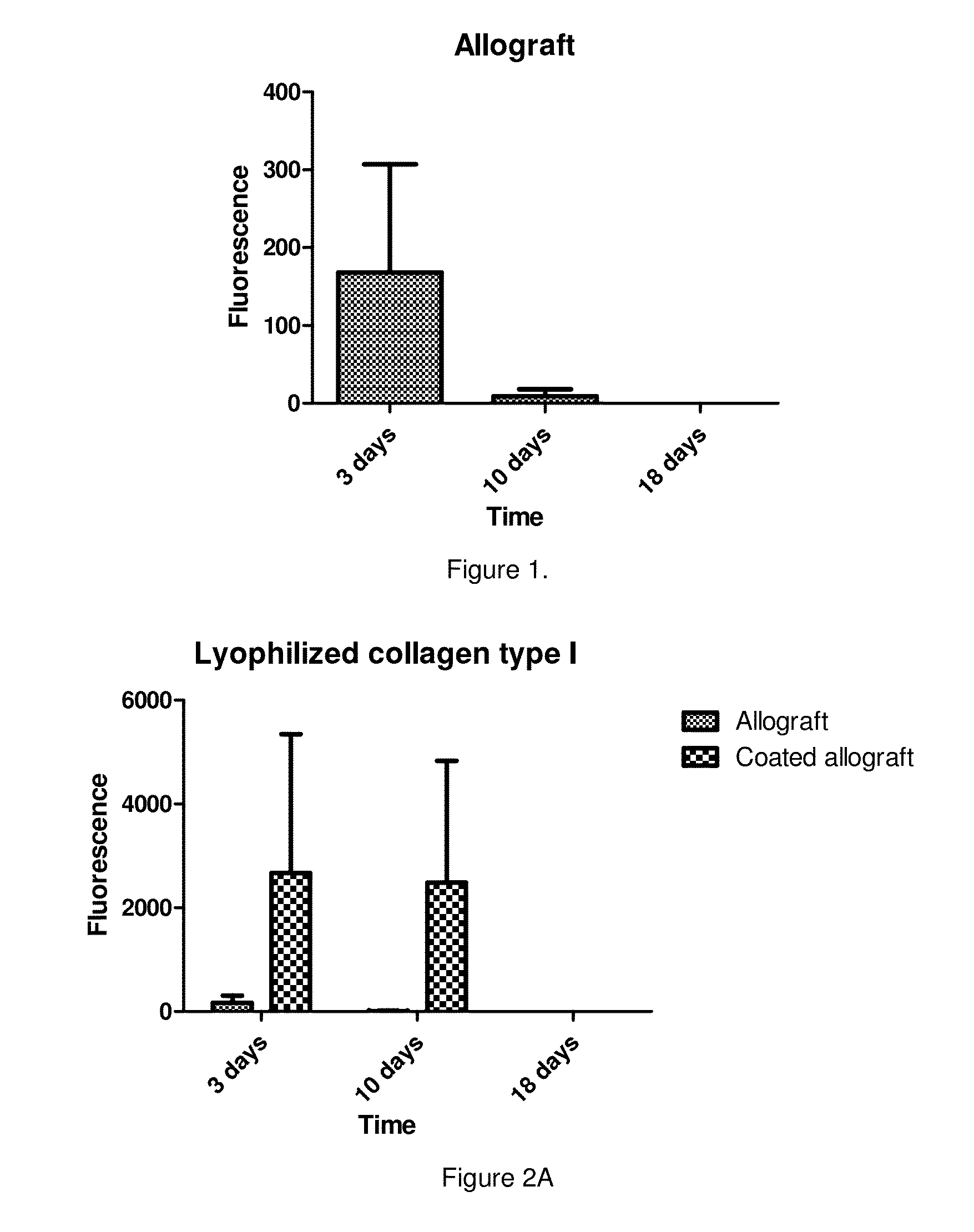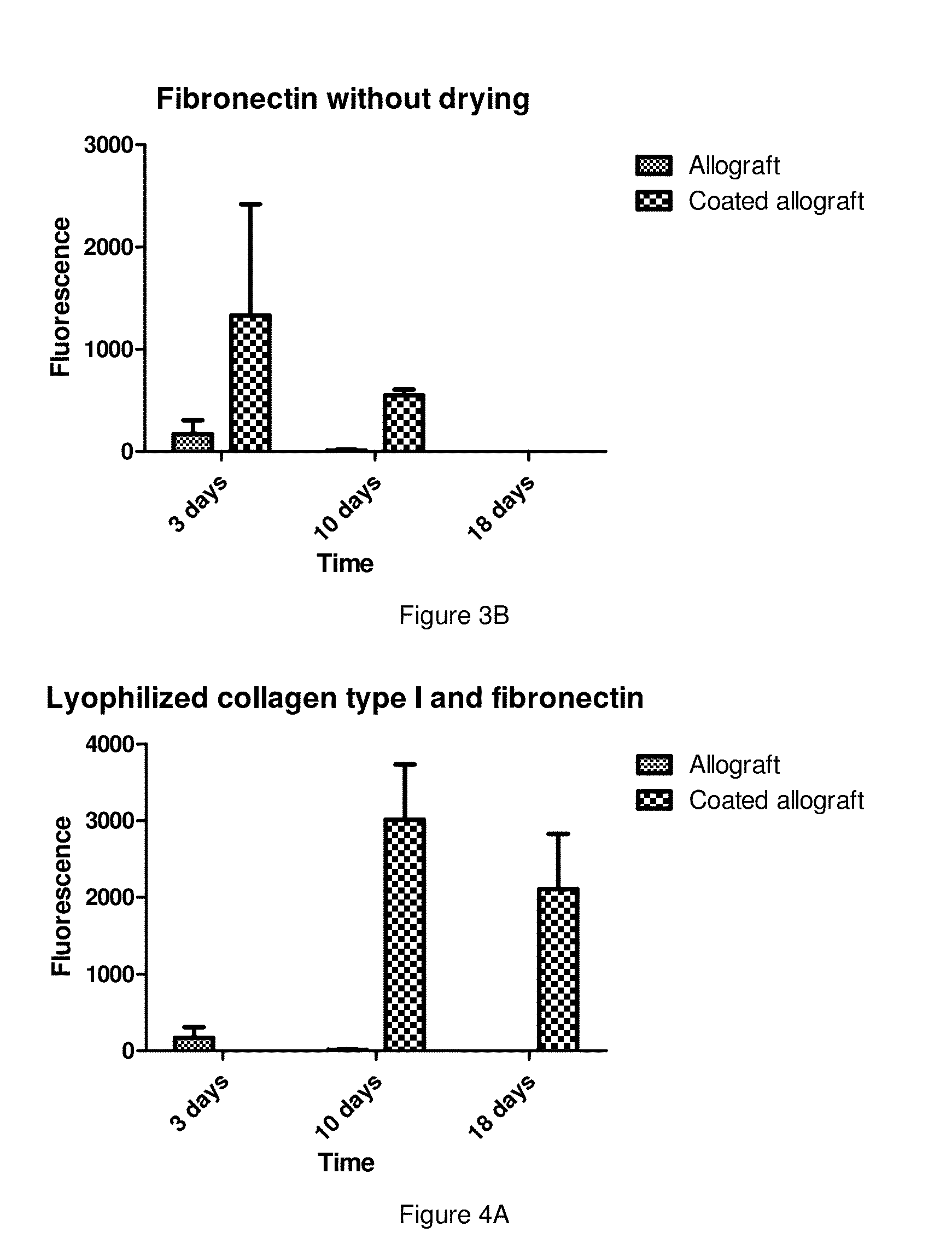Method for Producing an Implantable Bone Composition
a bone composition and bone technology, applied in the direction of biocide, prosthesis, antibody medical ingredients, etc., can solve the problems of limited availability and significant morbidity of blood loss, limited use of autografts, and increased operative time, so as to reduce the chance of immunological complication, improve the mechanical stability of the graft, and improve the effect of adheren
- Summary
- Abstract
- Description
- Claims
- Application Information
AI Technical Summary
Benefits of technology
Problems solved by technology
Method used
Image
Examples
example 1
Preparation and Investigation of Allografts
Isolation and Culture of Mesenchymal Stem Cells
[0047]Bone marrow derived mesenchymal stem cells (MSCs) were isolated from human bone marrow, and were expanded in DMEM culture medium containing 10% fetal calf serum, 2 mM L-glutamine, 100 U / ml penicillin and 100 μg / ml streptomycin. The bone marrow samples were obtained from young males and females aged 2-20. Only such tissues were used, that otherwise would have been discarded. Semmelweis Orthopedic Clinic Management Committee, Budapest, Hungary, approved the use of these tissues. The bone marrow was taken into T75 flasks, and diluted with DMEM culture medium. This mixture was stored in incubator at 37° C. in 5% CO2 for 3 days. After the incubation time, the MSCs adhered to the surface of the flask and the remnant components of bone marrow were eliminated by washing with PBS. The used cells were between 1 and 5 passages during the experiment.
Characterization of MSCs
[0048]The identity of the a...
example 2
Animal Bone Coated with Freeze-Dried Human Albumin
Preparation and Coating of Rat Bone Allografts
[0053]Wistar rat (400-450 g) femurs were harvested to use them as rat bone allografts. Following the removal of bone marrow the rat femurs were milled to homogenous bone particles with a diameter of 1 mm Subsequently, the obtained rat bone particles were immersed into human albumin solution and incubated at +4° C. overnight then the human albumin was freeze-dried onto the surface of said bone particles. The conditions of the freeze-drying: 32° C., at 0.5 Pa for 24 hours.
Retrieval of Rat Bone Marrow Derived Stem Cells
[0054]Wistar rat (400-450 g) femurs were harvested to retrieve bone marrow derived stem cells. After the harvest of rat femurs their proximal and distal ends were dissected and the bone marrow was flushed into Petri-dishes using DMEM culture medium comprising 10% FCS, 100 U / ml penicillin and 10 μg / ml streptomycin, 2 mM L-glutamine and 1 g / l glucose. The adhered cells at the bo...
example 3
Materials and Methods
[0056]The osseointegration ability of lyophilized bone grafts coated with freeze-dried human serum albumin was investigated in an animal model. In the first stage of the study a psuedoarthrosis model was developed. On Wistar rats' (400-450 g) femur a 2-3 mm wide transverse middiaphyseal osteotomy had been performed then the bone ends were fixed by plate and screws. Polymethyl methacrylate (PMMA) spacer was placed between the osteotomy sites and the periosteum was removed from the prepared femur to block natural bone healing. After 4 weeks the operation the PMMA plate was removed and the osteotomy gap was left empty further 4 weeks. Following 4 weeks post-operative period the animals were sacrificed and their femurs were harvested and subjected to μCT examination to prove the development of a pseudarthrosis. In the second stage, the pseudoarthrosis model was prepared just as above detailed, but following the removal of the PMMA spacers uncoated lyophi...
PUM
 Login to View More
Login to View More Abstract
Description
Claims
Application Information
 Login to View More
Login to View More - R&D
- Intellectual Property
- Life Sciences
- Materials
- Tech Scout
- Unparalleled Data Quality
- Higher Quality Content
- 60% Fewer Hallucinations
Browse by: Latest US Patents, China's latest patents, Technical Efficacy Thesaurus, Application Domain, Technology Topic, Popular Technical Reports.
© 2025 PatSnap. All rights reserved.Legal|Privacy policy|Modern Slavery Act Transparency Statement|Sitemap|About US| Contact US: help@patsnap.com



